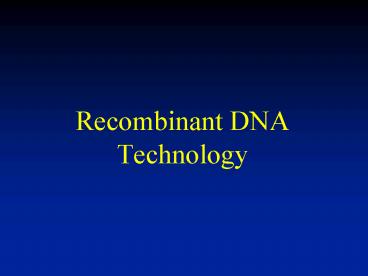Recombinant DNA Technology - PowerPoint PPT Presentation
1 / 34
Title:
Recombinant DNA Technology
Description:
3. Size of DNA that can be put into bacteria is limited ... Promega Corp; Madison, WI. pGEM-3Z, e.g. Ampr. lacZ. polycloning site in lacZ gene ... – PowerPoint PPT presentation
Number of Views:327
Avg rating:3.0/5.0
Title: Recombinant DNA Technology
1
Recombinant DNATechnology
2
Why Do Genetic Engineering?
- 1. Produce desired proteins in vitro for
therapeutic use. - 2. Have rice produce as much starch as a kernel
of corn (in vivo production). - 3. Gene therapy
3
Steps in Genetic Engineering
- 1. Isolation of gene of interest
- 2. Isolation of plasmid DNA
- 3. Manipulation of DNA sequence
- a. Cutting- Restriction enzymes
- b. Splicing- DNA ligase
- 4. Transformation of bacteria
- 5. Selection of correct bacteria
4
Prokaryote Advantages
- 1. Grow fast
- 2. Manipulation easier
- 3. Eukaryotic technology still embryonic
5
Prokaryote Disadvantages
- 1. Cant splice out introns
- 2. Introns are needed for good expression
- 3. Size of DNA that can be put into bacteria is
limited - 4. Prokaryotes dont glycosylate proteins
6
Plasmids
- Plasmid- small, circular, extrachromosomal DNA
which replicates independently of host
chromosomal DNA
7
Isolation of Plasmid DNA
8
Plasmid map
- Ori
- antibiotic resistance gene(s)
- restriction sites
- Figure Harpers Review of Biochemistry
9
Manipulation of DNA Sequence
10
Restriction enzymes
- Restriction enzyme- an enzyme which cuts specific
DNA sequences, endonuclease - blunt end vs. sticky end
- Cleavage is restricted to specific, 4-6 bp
sequences (foreign bacteria) always palindromic
sequence - More than 800 are now known
11
Restriction Endonucleases
- Type I- multisubunit, endonuclease and methylase
activities, cleave at random up to 1000 bp from
recognition sequence - Type II- cleave DNA within recognition sequence,
require no ATP, most monomers - Type III- multisubunit, endonuclease and
methylase about 25 bp from recognition sequence
12
Restriction Endonucleases
- EcoRI E. coli strain R 1st enzyme found
- GAATTC G AATTC
- CTTAAG CTTAA G
- HpaI GTTAAC GTT AAC
- CAATTG CAA TTG
13
Generating a Plasmid map
- restriction sites
- sizes when insert included
14
Cloning Vectors
- 1. Plasmids- 5,000 to 400,000 bp
- useful for putting 0.01-10 kb in
- 2. Bacteriophages-virus that infects bacteria
- useful for putting 10-20 kb in
- 3. Cosmids- artificially generated
- useful for putting 20-50 kb in
- 4. YACs- yeast artificial chromosomes
- new, 500 kb
15
Transformation of Bacteria
16
CaPO4 Transformation
- Cells and DNA incubated together in CaCl2 at 0oC,
then heat shock at 37oC - How this makes cells competent to take up DNA
is not known - Only a small percent of cells take up DNA- must
select for them
17
Newer Methods of Transformation
- Lipofectin and similar molecules
- Electroporation
- Microinjection
18
Last Time
- Restriction Enzymes
- Plasmid Maps
- Other Vectors
- Transformation
19
Selection of Correct Bacteria
20
Antibiotic Resistance Genes are a Part of Many
(Constructed) Plasmids
21
Blue-White ScreeningPromega Corp Madison, WI
- pGEM-3Z, e.g.
- Ampr
- lacZ
- polycloning site in lacZ gene
- T7 promoter one side, SP6 other
22
DNA Sequencing
- Sangers first
- Radiolabeled vs. fluorescent tag
23
Isolation of Gene of Interest
24
Isolation of Gene of Interest Use of Antibodies
- Ab ppt protein
- Prot being synth on mRNA
- Generate cDNA
- reverse transcriptase
- DNA polymerase
- Must have protein in pure form
25
Isolation of Gene of Interest Genomic Library
Screening
- Isolation of total genome
- Fragments and their sizes
- How many fragments to get entire genome can be
calculated - Fragments put into a vector
- Vectors are hybridized with a probe
- Dont need protein, but must know at least part
of sequence
26
Hybridization
- Bacterial colonies containing plasmid library are
grown up - Paper is used to pick up cells of each colony
- Paper is incubated in radiolabeled probe and
washed - Autorad of paper Ids colonies containing gene of
interest - Figure Stryer, Biochemistry
27
Isolation of Gene of InterestPolymerase Chain
Reaction (PCR)
- Taq polymerase
- Equipment- thermocycler
- Procedure- Taq template primer
- Dont need protein, but must know at least part
of sequence - The real power here is ability to amplify DNA
28
Summary Figure Stryer, Biochemistry
29
Summary Figure after Stryer, Biochemistry
30
Summary Figure after Stryer, Biochemistry
31
Summary Figure after Stryer, Biochemistry
32
Summary Figure after Stryer, Biochemistry
33
Summary Figure after Stryer, Biochemistry
34
Summary Figure after Stryer, Biochemistry































